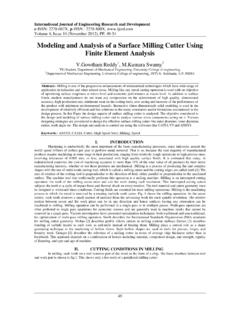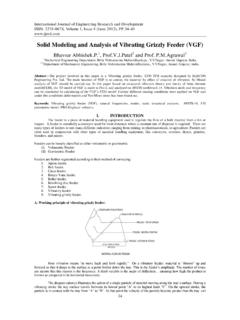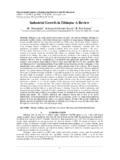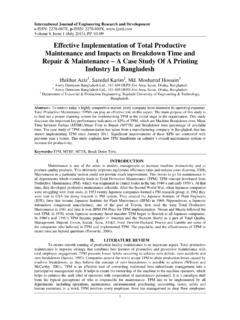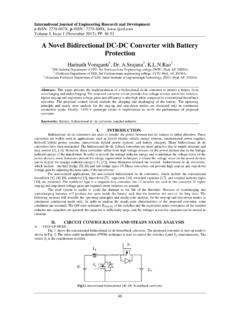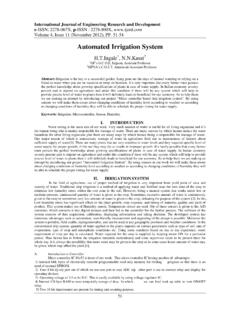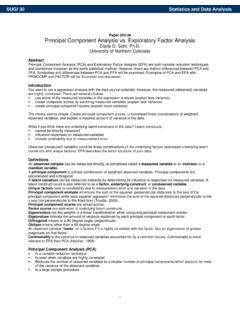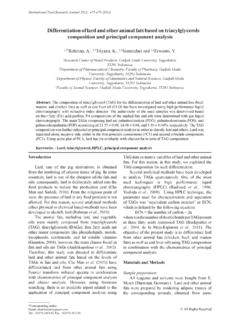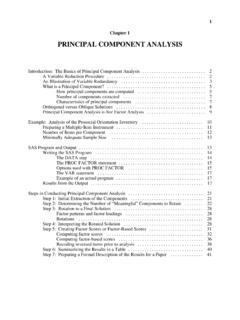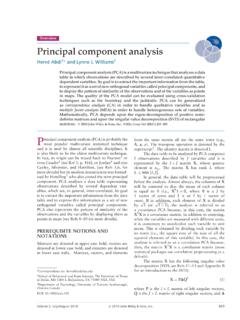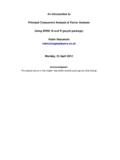Transcription of SWOT ANALYSIS – A TEXTILE COMPANY CASE STUDY
1 International Journal of Engineering Research and Development ISSN: 2278-067X, Volume 1, Issue 9 (June 2012), 46 Application of swot and principal component ANALYSIS in a TEXTILE COMPANY - A case STUDY Jeyaraj1, C. Muralidharan2, T. Senthilvelan3, Deshmukh4 1 Research Scholar, Department of Manufacturing Engineering, Annamalai University, Chidambaram - 608002, TamilNadu, India, 2 Professor, Department of Manufacturing Engineering, Annamalai University, Chidambaram - 608002, TamilNadu, India, 3 Professor, Department of Mechanical Engineering, Pondicherry Engineering College, Pondicherry - 605014, Pondicherry, India, 4 Professor, Department of Mechanical Engineering, Indian Institute of Technology Delhi, New Delhi - 110016, India, Abstract Many companies are conducting a swot ANALYSIS as part of their strategic planning.
2 This is the process to identify the strengths, weaknesses, opportunities and threats before proceeding to the formulation of their long and short term strategy. This article seeks to identify the swot variables to make better strategic planning through empirical STUDY . After identifying thirty three swot variables, a rating type questionnaire have been made, and all the top management, managerial level and supervisory level (125 no) staff members were surveyed by interview method in a leading TEXTILE COMPANY in south India. principal component ANALYSIS was used to reduce and group the swot variables.
3 From this ANALYSIS nine non-significant variables are removed from the swot data set, and twenty four are found as significant for further ANALYSIS . After identifying twenty four swot variables, swot matrix was formed based the prioritized swot variables with four quadrants; maxi mini (ST strategy), mini mini (WT strategy), mini maxi (WO strategy) and maxi-maxi (SO strategy). This will help the COMPANY to overcome the external threats and also to plan their short term and long term strategies. Keywords swot ANALYSIS , TEXTILE , Strategic Planning, principal component ANALYSIS , case STUDY I. INTRODUCTION TO swot ANALYSIS Many companies are conducting a swot ANALYSIS as part of the strategic planning process to identify strengths, weaknesses, opportunities and threats before proceeding to the formulation of a strategy (Houben et al.)
4 , 1999; Roth and Washburn, 1999). swot ANALYSIS , meaning the ANALYSIS of key or critical success factors, belongs to the highest ranked set of techniques of strategic ANALYSIS used by firms in empirical surveys (Glaister and Falshaw, 1999). Most of literatures are covering the strategic planning process; most approaches include a cyclic iteration of the following five elements. (i) Strategic planning process begins with a statement of the corporate mission and goals. (ii) ANALYSIS of the organization s external competitive environment. (iii) ANALYSIS of the organization s internal operating environment.
5 (iv) Selection of focused organization strategies. (v) Implementation of the selected strategies. The last step also involves the design of the organizational structure and control systems necessary to implement the chosen strategy (Hax and Majluf, 1991). The focus of this article lies upon step 2 (external ANALYSIS ) and step 3 (internal ANALYSIS ). The main purpose of the external ANALYSIS is to identify opportunities and threats in the organization s operating environment, while the internal ANALYSIS seeks to count the organization s strengths and weaknesses. AN OVERVIEW OF INDIAN TEXTILE INDUSTRY The Indian TEXTILE Industry has an overwhelming presence in the economic life of the country.
6 Apart from providing one of the basic necessities of life, the TEXTILE industry also plays a pivotal role through its contribution to industrial output, employment generation, and the export earnings of the country. It contributes about 14 per cent to industrial production, 4 percent to the GDP, and percent to the country's export earnings. It would provide direct employment to over 35 million people by 2010 to 2011 (Texmin 2005). The TEXTILE sector is the second largest provider of employment after agriculture. Thus, the growth and all round development of this industry has a direct bearing on the improvement of the economy of the nation.
7 In India s current scenario, TEXTILE industry is facing more challenges (cotton and yarn price fluctuation, effluent treatment and discharge, customer expectation on high quality and disposal of solid waste) from all the areas of business. For facing these challenges, organization has to plan their effective long and short range strategy. Before starting the strategic planning, the organization has to identify their internal capabilities and their competitive environment. swot ANALYSIS is one of the self evaluating tools to measure the COMPANY internal capabilities and external competitive environment.
8 In this article the swot ANALYSIS of a leading TEXTILE COMPANY in south India is dealt. This COMPANY is having its entire value chain of TEXTILE process. Our research interest is the processing unit (dyeing, printing and finishing) of that COMPANY . TEXTILE processing is the most critical link in the TEXTILE value chain (Figure 1) of any TEXTILE COMPANY . This article concentrates the TEXTILE processing unit s internal and external ANALYSIS ( swot ) for determining its short and long range strategy. Application of swot and principal component ANALYSIS in a TEXTILE COMPANY - A case STUDY 47 Figure 1: TEXTILE industry value chain INTRODUCTION TO principal component ANALYSIS (PCA) swot ANALYSIS can determine a perfect foundation for successful strategy formulation (Kajanus et al.)
9 , 2004). However, swot ANALYSIS has weakness in the measurement and evaluation steps (Hill and Westbrook, 1994, Christianson, 2002). As planning processes are often complicated and difficult by numerous criteria, it may be that utilization of swot is insufficient to assess the appropriateness of decision alternatives based on these factors. Therefore, swot ANALYSIS alone cannot comprehensively assess the strategic decision-making process (Shrestha et al., 2004, Kurttlia et al 2000). principal component ANALYSIS (PCA) is a standard tool used in diverse fields from neuroscience to computer graphics - because it is a simple, non-parametric method for extracting relevant information from confusing data sets.
10 With minimal effort PCA provides a method to reduce a complex data set to a lower dimension to reveal the sometimes hidden, simplified structures that often underlie it (Jonathan, 2009). It is one of the most widely used multivariate technique which involves a mathematical procedure that transforms a number of correlated variables into a lesser number of uncorrelated variables called principal components (Alberto, 2000). Even though the objective of PCA may be to reduce the number of variables of a dataset it retains most of the original variability in the data. The first principal component accounts for as much of the data variability as possible and succeeding components account for as much of the remaining variability as possible (Hair et al.)
